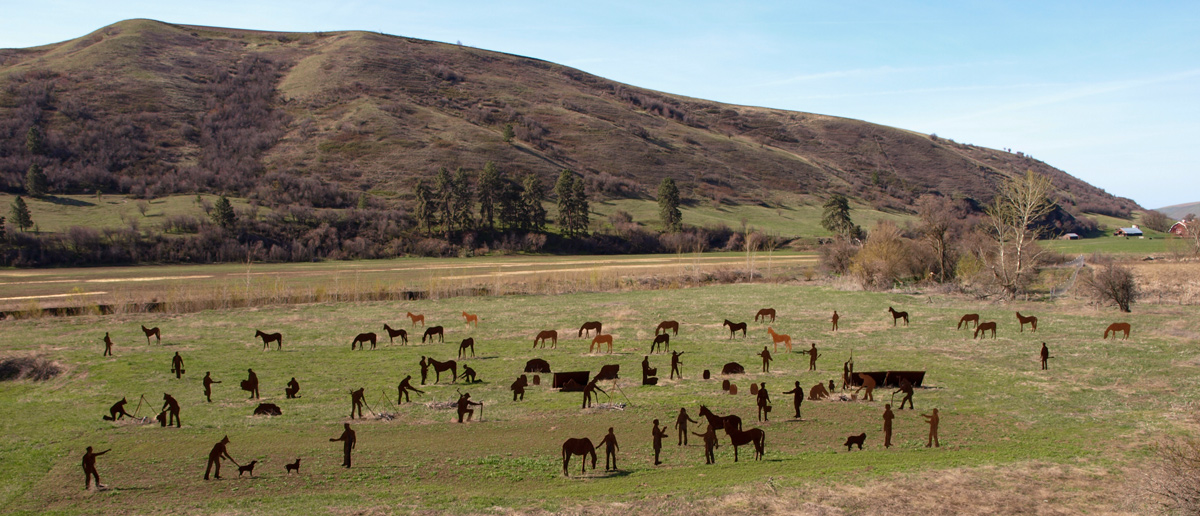The day begins with considerable time and effort collecting horses. An Indian brings in a stray and is given a tomahawk, knife, and pants. The expedition then continues along the north hills of the Touchet River. Near present Dayton, Washington, they turn up Patit Creek and encamp where the trail leaves the valley.
17 Miles Back to Catch a Horse
by Yellowstone Public Radio[1]Originally aired weekdays by Yellowstone Public Radio during the Bicentennial observance of 2003-2006. Narrated by Hal Hansen. Scripts by Whit Hansen and Ed Jacobson. Produced by Leni Holliman. © … Continue reading
Patit Creek Encampment
© 2 May 2009 by Kristopher K. Townsend. Permission to use granted under the Creative Commons Attribution-Share Alike 4.0 International license.
Patit Creek Encampment
we passed the small creek at 8¾ from the commencement of this course and encamped on the N. side in a little bottom, having traveled 19 miles today. at this place the road leaves the creek and takes the open high plain.
—Meriwether Lewis
Collecting Horses
a clear cold morning. the men got up all but one of our best horses which they could not find. Several hunters went on up the branch a hunting. Several of the men went out in different directions to look for the lost horse. one of them went back to where we took dinner yesterday and turned back. was Soon overtaken by an Indian who had caught our horse & was takeing him to us. as soon as the Indians returned him to us our officers gave a tommahawk knife and a pr. overalls for the kindness.
—John Ordway
Touchet River Valley
we immediately loaded up and set forward. steered East 3 M. over a over a hilly road along the N. side of the Creek, wide bottom on S. side. a branch falls in on S. side which runs south towards the S. W. mountains which appear to be about 25 Ms. distant low yet covered with snow N. 75 E. 7 through an extensive level bottom. more timber than usual on the creek, some pine of the long leafed kind appears on the sides of the creek hills
—Meriwether Lewis
Patit Creek Bottoms
I observed considerable quantities of the quâ-mash in the bottoms through which we passed this evening now in blume. there is much appearance of beaver and otter along these creeks. saw two deer at a distance; also observed many sandhill crains Curloos and other fowls common to the plains. the soil appears to improve as we advance on this road. our hunters killed a duck only.
—Meriwether Lewis
Weather Diary
State of the Weather at rise
Wind at rise
State of the Weather at 4 P.M. Wind at 4 P.M. State of the Kooskooskee fair after cloudy N. E. fair S W cold this morning, some dew.
—Meriwether Lewis[2]To assist the reader of this web page, the date column is not presented, the river columns have been merged, and some abbreviations have been spelled out.
Travois Road is a High Potential Historic Site along the Lewis and Clark National Historic Trail managed by the U.S. National Park Service. The old trail stretches from the mouth of the Walla Walla River to the confluence of the Snake and Clearwater rivers. Sites include Lewis & Clark Trail State Park, The Encampment (Dayton, Washington), and Chief Timothy State Park.
Notes
| ↑1 | Originally aired weekdays by Yellowstone Public Radio during the Bicentennial observance of 2003-2006. Narrated by Hal Hansen. Scripts by Whit Hansen and Ed Jacobson. Produced by Leni Holliman. © 2003 by Yellowstone Public Radio. |
|---|---|
| ↑2 | To assist the reader of this web page, the date column is not presented, the river columns have been merged, and some abbreviations have been spelled out. |



